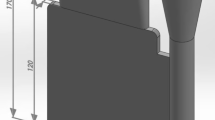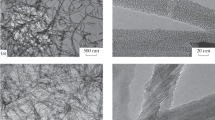Abstract
A technology of metal modification with carbon nanotubes (CNTs) is developed using electric arc surfacing. It involves the use of extruded metal rods containing CNTs as a deposited material. This technology is used to modify an AMg5 alloy. A comparison of the macro- and microstructures of the metal modified by the developed technology by adding CNTs and the corresponding unmodified metal does not reveal a significant difference. However, CNTs are detected in the modified metal using scanning electron microscopy, and microhardness analysis shows that the addition of CNTs increases the microhardness of the upper layers of the deposited metal.






Similar content being viewed by others
REFERENCES
R. Ruoff and D. Lorents, Carbon 33, 925 (1995).
M. Treacy, T. Ebbesen, and J. Gibson, Nature 381, 678 (1996).
E. Wong, P. Sheehan, and C. Lieber, Science 277, 1971 (1997).
S. C. Tjong, “Recent progress in the development and properties of novel metal matrix nanocomposites reinforced with carbon nanotubes and graphene nanosheets,” Mater. Sci. Eng. Rep. 74, 281–350 (2013).
R. George, K. T. Kashyap, R. Rahul, and S. Yamdagni, “Strengthening in carbonnanotube/aluminium (CNT/Al) composites,” Scr. Mater. 53, 1159–1163 (2005).
M. Bastwros, Kim, et al., “Effect of ball milling on graphene reinforced Al6061 composite fabricated by semi-solid sintering,” Composites B 60, 111–118 (2014).
J. Wang, Z. Li, G. Fan, H. Pan, Z. Chen, and D. Zhang, “Reinforcement with graphene nanosheets in aluminum matrix composites,” Scr. Mater. 66, 594–597 (2012).
M. Fattahi, N. Nabhani, E. Reshidkhani, Y. Fattahi, S. Akhavan, and N. Arabian, “A new technique for the strengthening of aluminum tungsten inert gas weld metals using carbon nanotube/aluminum composite as a filler metal,” Micron, Nos. 54–55, 28–35 (2013).
M. Fattahi, A. R. Gholami, A. Eynalvandpour, E. Ahmadi, Y. Fattahi, and S. Akhavan, “Improved microstructure and mechanical properties in gas tungsten arc welded aluminum joints by using graphene nanosheets/aluminum composite filler wires,” Micron, No. 64, 20–27 (2014).
O. Panchenko, S. Ivanov, T. Kol’tsova, and V. Michailov, “Survivability of carbon nanotubes arc welding,” in Proceedings of 8th International Conference Nanocon 2016 on Nanomaterials—Research and Application (2016), pp. 59–63.
Funding
The work was carried out at Peter the Great St. Petersburg Polytechnic University under contract no. 14. Y30.18.3670-MK.
Author information
Authors and Affiliations
Corresponding author
Additional information
Translated by K. Shakhlevich
Rights and permissions
About this article
Cite this article
Isupov, F.Y., Zamozdra, M.Y., Mushnikov, I.V. et al. Use of Carbon Nanotubes for Modifying the Microstructure and Mechanical Properties of Al–Mg Alloys. Russ. Metall. 2020, 1537–1541 (2020). https://doi.org/10.1134/S0036029520130121
Received:
Revised:
Accepted:
Published:
Issue Date:
DOI: https://doi.org/10.1134/S0036029520130121




